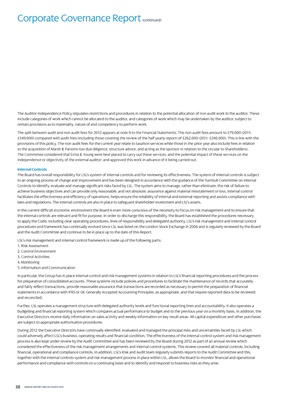
Corporate Governance Report (continued)
The Auditor Independence Policy stipulates restrictions and procedures in relation to the potential allocation of non audit work to the auditor. These
include categories of work which cannot be allocated to the auditor, and categories of work which may be undertaken by the auditor, subject to
certain provisions as to materiality, nature of and competency to perform work.
The split between audit and non audit fees for 2012 appears at note 9 to the Financial Statements. The non audit fees amount to £79,000 (2011:
£349,000) compared with audit fees (including those covering the review of the half yearly report) of £262,000 (2011: £240,000). This is line with the
provisions of this policy. The non audit fees for the current year relate to taxation services while those in the prior year also include fees in relation
to the acquisition of Marsh & Parsons (tax due diligence, structure advice, and acting as the sponsor in relation to the circular to Shareholders).
The Committee considered that Ernst & Young were best placed to carry out these services, and the potential impact of these services on the
independence or objectivity of the external auditor; and approved this work in advance of it being carried out.
internal controls
The Board has overall responsibility for LSL’s system of internal controls and for reviewing its effectiveness. The system of internal controls is subject
to an ongoing process of change and improvement and has been designed in accordance with the guidance of the Turnbull Committee on Internal
Controls to identify, evaluate and manage significant risks faced by LSL. The system aims to manage, rather than eliminate, the risk of failure to
achieve business objectives and can provide only reasonable, and not absolute, assurance against material misstatement or loss. Internal control
facilitates the effectiveness and efficiency of operations, helps ensure the reliability of internal and external reporting and assists compliance with
laws and regulations. The internal controls are also in place to safeguard shareholder investment and LSL’s assets.
In the current difficult economic environment the Board is even more conscious of the necessity to focus on risk management and to ensure that
the internal controls are relevant and fit for purpose. In order to discharge this responsibility, the Board has established the procedures necessary
to apply the Code, including clear operating procedures, lines of responsibility and delegated authority. LSL’s risk management and internal control
procedures and framework has continually evolved since LSL was listed on the London Stock Exchange in 2006 and is regularly reviewed by the Board
and the Audit Committee and continue to be in place up to the date of this Report.
LSL’s risk management and internal control framework is made up of the following parts:
1. Risk Assessment
2. Control Environment
3. Control Activities
4. Monitoring
5. Information and Communication
In particular, the Group has in place internal control and risk management systems in relation to LSL’s financial reporting procedures and the process
for preparation of consolidated accounts. These systems include policies and procedures to facilitate the maintenance of records that accurately
and fairly reflect transactions, provide reasonable assurance that transactions are recorded as necessary to permit the preparation of financial
statements in accordance with IFRS or UK Generally Accepted Accounting Principles, as appropriate, and that require reported data to be reviewed
and reconciled.
Further, LSL operates a management structure with delegated authority levels and functional reporting lines and accountability. It also operates a
budgeting and financial reporting system which compares actual performance to budget and to the previous year on a monthly basis. In addition, the
Executive Directors receive daily information on sales activity and weekly information on key result areas. All capital expenditure and other purchases
are subject to appropriate authorisation procedures.
During 2012 the Executive Directors have continually identified, evaluated and managed the principal risks and uncertainties faced by LSL which
could adversely affect LSL’s business, operating results and financial condition. The effectiveness of the internal control system and risk management
process is also kept under review by the Audit Committee and has been reviewed by the Board during 2012 as part of an annual review which
considered the effectiveness of the risk management arrangements and internal control systems. This review covered all material controls, including
financial, operational and compliance controls. In addition, LSL’s Risk and Audit team regularly submits reports to the Audit Committee and this,
together with the internal controls system and risk management process in place within LSL, allows the Board to monitor financial and operational
performance and compliance with controls on a continuing basis and to identify and respond to business risks as they arise.
38 ANNUAL REPORT AND ACCOUNTS 2012